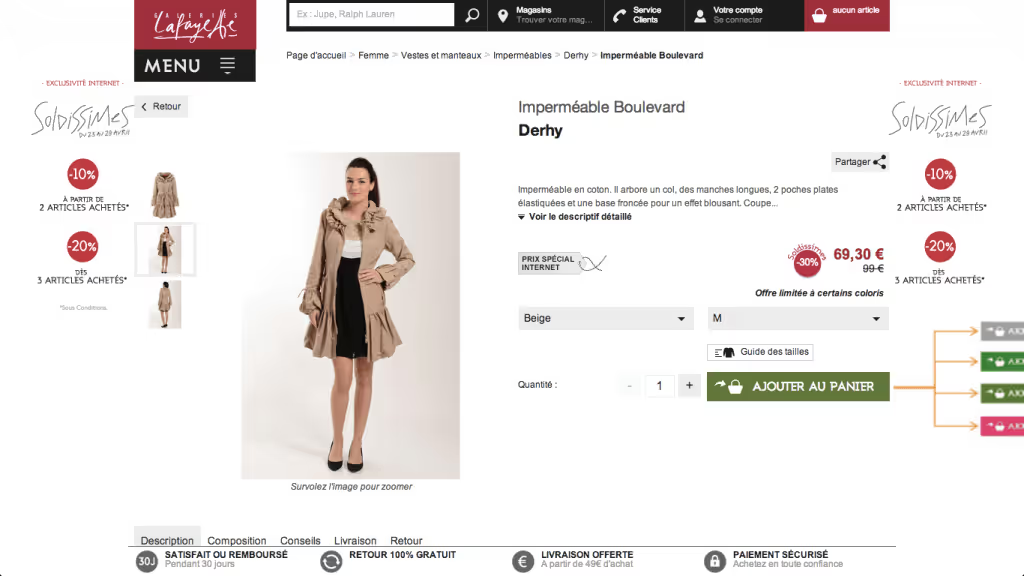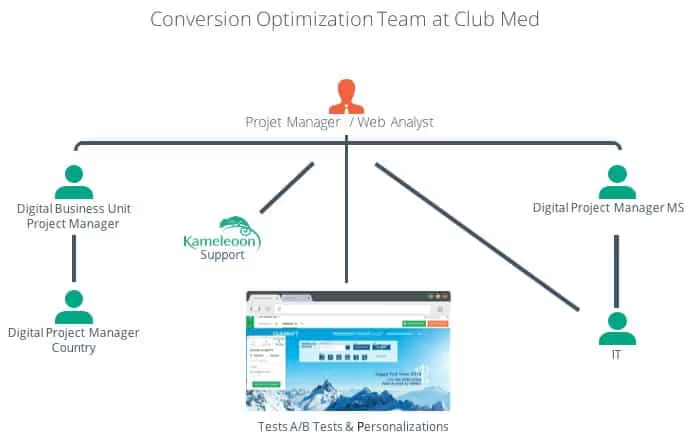Build a Conversion Rate Optimization Team in 5 steps

Whether you’re a beginner or an expert, work in a small or big company, a successful A/B Testing practice plays a key role in your conversion rate optimization strategies. This article is for project managers, marketers or technical managers who want to build an effective Conversion Optimization team.
“Alone we go faster, together we go further.”
A/B Testing is not a silver bullet. It’s science, with rigorous processes.
So, how do you make sure you get conclusive results over time? Which role for whom in your team? What qualities should you develop to become a conversion champion? Should you hire?

- Mistakes: without a process, someone could stop or launch a test when he/she shouldn’t.
- Redundancy: you could run similar tests at the same time.
- Ineffectiveness: if your team doesn’t communicate the results, your tests will be mostly shots in the dark as you won’t be able to get reusable insights.
We think a conversion optimization strategy must come from a global business and marketing analysis. A/B Testing is a team effort; you must be smart and deliberate about who does what to achieve your goals.
All right, so how do you build a team of CRO champions?
I. Learn the rules
CRO practices evolve as fast as everything in the digital world. Beginner or expert, you need to stay up-to-date and re-learn the rules regularly to build a successful conversion funnel.
There are three steps in conversion optimization that you could easily outsource:
- Identification of potential optimizations
- Technical implementation of the tests
- Analysis of the results

However, if you can handle everything yourself, it does hold several advantages:
- It’s cost-effective
- You’ll learn more
- You’ll do more tests. Some of our clients run up to 8 tests/week after only one year of practice.
- More money!
The Galeries Lafayette are the perfect example of a well-established brand that was late to embrace the web, but had a strong desire to succeed.
At first, they outsourced the ideation and implementation of their A/B tests to a conversion optimization agency while using our platform. Proceeding that way allowed them to quickly get their first “success stories,” which in turn popularized the web testing practice internally.

Others preferred to do everything in-house from the get-go and put A/B Testing at the core of their marketing strategy.
That’s what Reezocar—a startup created in 2013 who helps people look for and buy second-hand vehicles in Europe, did.
Their reasoning was:
"We wanted our website to match what our visitors were expecting—regarding navigation for example, where A/B Testing particularly shines. Asking the right questions from the start was essential to set up for success in the long run. Because improving your website after the facts—or completely revamping it, costs time and money.”

- Be analytical and data-driven
- Be methodical and know how to follow rigorous processes
- Always try to improve
- Be curious: look for inspiration everywhere
- Don’t brag: leave your ego behind
- Be patient: how long you need to wait before seeing results depends on your traffic.
II. Going from outsourced testing to internal: the skill transfer
If outsourcing is sometimes the best short-term solution, it rarely is in the long run. It’s essential your team keeps learning more and more about your visitors/clients and doesn’t leave this information to the agency you hired.
Moreover, being autonomous is the only way you’ll be able to get past 3–4 tests a month. Often, the biggest obstacle to practicing A/B Testing is resistance from the teams: people just don’t see the benefits.
Usually, the right moment to transfer skills comes after about a dozen of tests were run. People then have observed substantive gains and see the ROI.
Skill transfer needs to be anticipated, done gradually and depends on the profile of your team.
- If it’s a marketing team, identification of priorities and test ideation is the best thing to learn.
- If your team is technical, you can go in tests implementation.
- If you have web analysts, learn how to analyze test results.
We saw skill transfers last from 1 month to a year—with an average of 3 months, depending on the size of the organization.
Its success is largely dependent on how good the agency you hired is at A/B Testing (be it use of the tools or in the implementation of organizational processes).
III. Build your stamina
Optimizing a website takes time, so does the implementation of an organizational process.
We identified four stages in the maturity of an A/B Testing practice.
1. Occasional: you’re testing the water
Companies usually first start with a series of tests in the context of a website redesign. It’s ideal for continual improvement process, but sometimes businesses prefer to stop there and do punctual test campaigns.
2. Ongoing: you’re gaining traction
You’re now proactive in the identification of underperforming pages, regularly test new hypothesis and measure your visitors’ engagement. You’re learning more about them and start to anticipate their needs.
3. Iterative: almost here!
Your organization is in a constant optimization logic. Each test validates a hypothesis on high-impact pages and becomes the base for the next tests. By capitalizing on what you learn, the chances of finding your next conversion points are multiplied: your ROI is excellent.
4. Systemic: you made it!
Testing is now entirely part of your process. You’re not trying to justify the relevance of A/B Testing anymore; you challenge every change and test its validity. Not tested? Not implemented.
IV. Choose a leader and assign roles to everyone
Without a leader to rally everyone, be the link between the team member and update the different documents, it’s hard to have a successful conversion optimization team
But what should be the skill set of your leader?
A/B testing must be mainly led by the e-commerce or marketing team because conversion optimization is a natural part of their goals.
Our experience shows that it’s paramount to have a project manager, to drive and coordinate all parties. He’ll define tests, make sure they’re well integrated, will manage earnings, ensure results are correctly recorded and analyzed.
Ideally, he will also be the A/B Testing evangelist in your organization. Make sure his profile corresponds with the leadership qualities required!
It’s best to associate him with a technical partner: it could be a front-end developer or a web marketer—with at least HTML and CSS knowledge. These types of profiles are more and more common in marketing teams as you need to operate directly on websites without involving IT every time.
For example, ClubMed has the following organization:

Renault has a different approach: as it’s not an e-commerce pure player (you usually don’t buy a car online) and it’s an international corporation.
However, optimizing the ergonomics of its website is an essential topic: a central team, who manages six countries, implements a standard solution then adapt its content depending on the territories.
The team has a project lead, technical lead, an Adobe expert, and analysts. There are country-specific teams who have complete ownership of their respective websites to validate every publication or stop any campaign.

M6Web—in the media sector, has yet another approach. Considering the evolution of their business models, optimizing conversions is a must.
Historically, conversion optimization management was divided among all their entities. But they now believe it to be a mistake. Nowadays, they have one leader to maximize learning.

Smaller companies prefer a more collaborative approach like Reezocar, who we mentioned earlier.
Any member, from any team, can propose test ideas. It’s then the leader’s role to revise and prioritize the tests.
In all those different approaches, it is highly recommended to have analysts. Your tests might be perfectly executed, if you can’t exploit your results and learn from them, your efforts will be vain.
V. Share everything, especially your results!
The practice of A/B Testing can be intense, at first you might be ecstatic or disappointed by your first results. It’s crucial you share your results and insights internally.
Every information linked to your tests—like your backlog is extremely useful to manage your marketing actions.

You can create your own internal process but make sure you leave a clear, short and precise document with at least the following:
- Current tests with a recognizable name and the page being tested.
- Which elements of the page are you testing and why?
- Who is responsible for which tests?
- Once they’re over, did they succeed? Fail?
Communicating results internally is often forgotten. Results are just transmitted to the e-commerce direction or even only among the people who implemented the test. It’s a shame because it has numerous benefits:
- Tests give out vital information on clients. Everyone from UX designers, CRM managers, marketing directors will benefit from the learnings.
- Tests spark discussions about what you learned and facilitate process optimization
- Tests validate the relevance of A/B testing. Everyone can easily measure ROI. It contributes to spreading a data-driven practice in your company.
Bonus: Hang that above your desk
How do you become an optimization conversion champion:
- Like wine, A/B tests effects get better with time… but only with the right process.
- A structured approach feeds motivation and will allow you to focus on what works.
- If you follow a rigorous process, everyone will improve individually in your team: your website will be better and your clients thankful.
- You’ll save time.
- Conversion optimization is not an individual task. It’ll encourage discussions and generate insights.
- With a leader, your team will achieve results quickly.
To conclude, when you start A/B Testing, you have two options. You can choose to stay an amateur, copy-paste what you read online and hope you get the same results; OR you can create and optimize detailed processes to continually improve, thus becoming a conversion champion.




